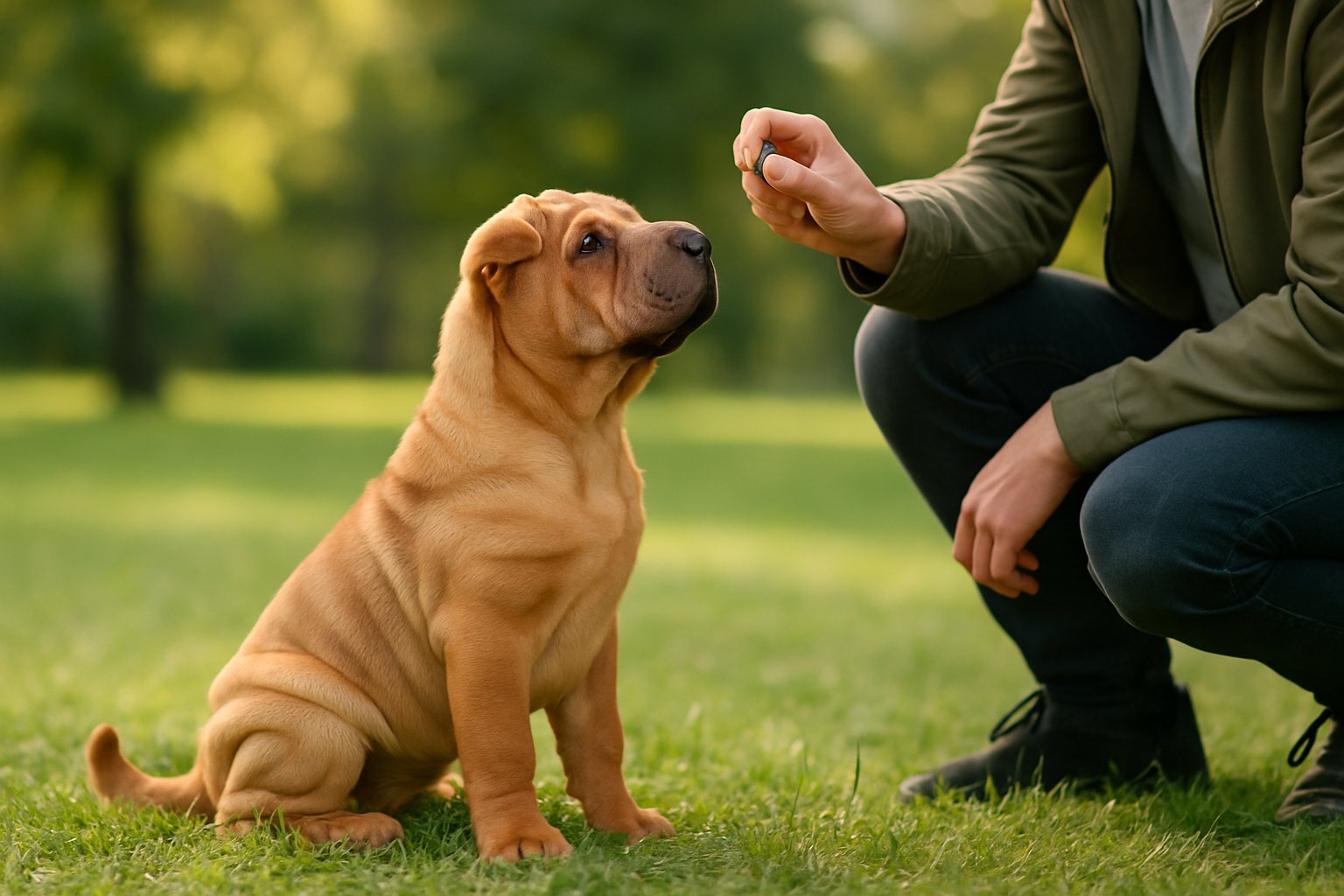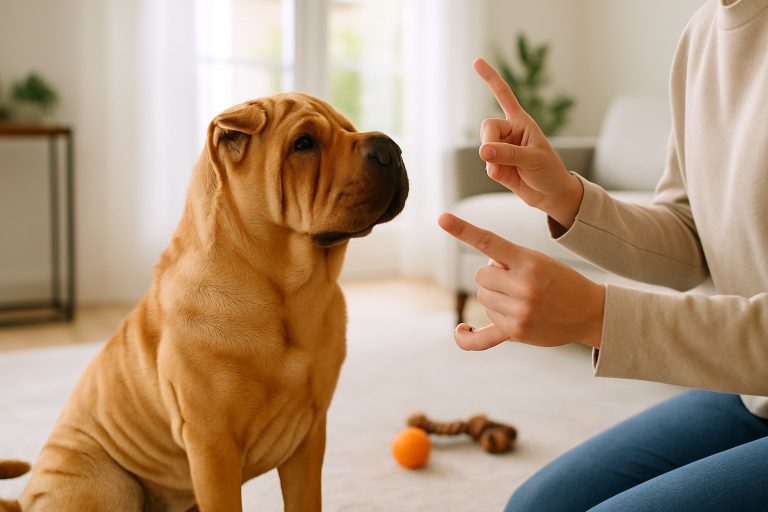Training your Chinese Shar-Pei can help you build a strong bond and enjoy a well-behaved companion. These dogs are known for their unique appearance and stubborn nature, which can make training challenging if you are not prepared.
Learning the right methods and tips makes it easier to guide your Shar-Pei toward good behavior. With the right approach, you can set your dog up for success and enjoy a peaceful home together.
1. Establish consistent leadership to prevent aggression.
Chinese Shar-Peis are known for being strong-willed and independent. This makes it important for you to take the lead from the very start. When your dog knows you are in charge, it is less likely to act out or show unwanted behaviors. Set clear rules and stick to them every day. Your Shar-Pei will respect you more if your directions are always the same. Calm and steady leadership helps create a sense of security for your dog, which in turn reduces the chance of aggression.
2. Use positive reinforcement to encourage good behavior.
- When training your Chinese Shar-Pei, positive reinforcement is one of the most effective methods you can use. This means you should reward your dog with treats, praise, or toys after it does something good. Rewarding the right behavior helps your Shar-Pei learn faster and makes training sessions more enjoyable.
- Shar-Peis respond well to kindness and motivation instead of punishment. Avoid yelling or harsh corrections, as these can make your dog stressed or stubborn. Instead, focus on encouraging good actions so your dog understands what you want.
- Be consistent with your rewards. Each time your Shar-Pei listens to a command or behaves well, give praise or offer a favorite treat. This will help the dog connect the action with a positive result and repeat it in the future.
- Using positive reinforcement builds a strong, trusting relationship between you and your Shar-Pei. This approach helps them learn commands and behaviors more quickly and reduces unwanted actions.

3. Start training early to build obedience.
- Begin training your Chinese Shar-Pei as soon as you bring your puppy home. Early training helps your dog learn what is expected and reduces the chance of bad habits forming.
- Puppies are most eager to please and learn new things around 8 weeks old. At this age, your Shar-Pei is more likely to respond well to simple commands like sit, stay, and come.
- Short, daily training sessions work best for young dogs. Keep lessons positive and use rewards like treats or praise to make the experience enjoyable.
- Early training lays a strong foundation for future obedience. As your Shar-Pei grows, you can add new commands and more advanced lessons with greater success.
- You can read more about when to begin lessons and learn about early training steps at this Chinese Shar-Pei puppy training guide and doglime’s tips for starting at 8 weeks old.
4. Avoid harsh punishment to maintain trust.
Using harsh punishment with your Chinese Shar-Pei can damage the bond between you and your dog. These dogs are sensitive and can easily lose trust if treated with anger or force. Fear-based methods may also cause stress or even aggressive behavior.
It is more effective to use positive reinforcement, such as treats, praise, or play, when your dog behaves well. This approach encourages your Shar-Pei to repeat good behaviors and helps build confidence. Experts recommend avoiding punishments like yelling, hitting, or other physical corrections, as these techniques often backfire and harm your relationship.
5. Socialize your Shar-Pei with other dogs and people.
- Socializing your Shar-Pei early is very important. This breed can be wary of strangers and other dogs if not exposed to new situations at a young age. Good socialization helps prevent fearful and aggressive behavior later in life.
- Start by letting your puppy meet friendly people and calm dogs in a safe setting. Puppy kindergarten classes are a useful way to give your Shar-Pei a chance to interact with others in a controlled environment. These classes can help your dog get used to new faces, other animals, and different sounds.
- Expose your Shar-Pei to different places, such as parks or pet-friendly stores. Short visits and positive experiences help your dog build confidence. Treats and praise work well to reward calm, friendly behavior during new encounters.
- Socialization should begin while your Shar-Pei is still a puppy, ideally around 10 weeks old. If you have an adult Shar-Pei, go slowly and keep meeting new people and dogs positive and safe. Patients and steady exposure to new situations will help your dog become well-adjusted and comfortable around others.
6. Be patient and persevere with training sessions.
Training your Chinese Shar-Pei takes time and repetition. These dogs are intelligent but can be stubborn, so quick results are unlikely. You might see slow progress at first, but that is normal for this breed. Stick with consistent daily training. Skipping sessions or changing routines often can set back your dog’s learning and make things more confusing for them. Always approach training sessions with a calm and positive attitude.
7. Keep training sessions short and engaging.
- Training a Chinese Shar-Pei is easier when sessions are short. Aim for 5 to 10 minutes each time. This helps your dog stay focused and interested.
- Long lessons can lead to boredom or frustration. A bored Shar-Pei is less likely to listen and remember what you teach. Shorter sessions work better for their independent nature.
- Try to train two or three times a day, rather than doing everything at once. Keep each session fun by mixing in games and using treats or praise as rewards.
- Changing activities during each session also helps your Shar-Pei stay engaged.
- Stopping on a positive note sets them up for success next time. Your Shar-Pei will look forward to training if it feels like a game, not a chore.

8. Use clear and firm commands for clarity.
- When training your Chinese Shar-Pei, speak in a calm, firm voice each time you give a command. This breed responds best when commands are simple and direct.
- Avoid using long sentences or mixed words. Stick to single-word commands like “sit,” “stay,” or “come.” Clear commands make it easier for your Shar-Pei to understand what you expect.
- Shar-Peis can become confused if your tone changes or you use different phrases for the same command. Always use the same word for each action.
- Consistency and clarity help reduce confusion. This approach makes it easier for your dog to connect your words with the correct behavior.
9. Address stubborn behavior with calm firmness.
- Chinese Shar-Peis are known for their strong-willed nature. If your dog is ignoring commands or testing boundaries, it is important to remain calm. Do not yell or lose your temper, as this can make your Shar-Pei more resistant to listening.
- Use a steady voice and clear commands every time. Consistency helps your dog understand what you expect. If your Shar-Pei does not follow a command, repeat it once or twice, then gently guide them to do the right thing.
- Avoid harsh punishment or physical corrections. Instead, use positive reinforcement, such as treats and praise, when your dog responds correctly. This builds trust and encourages your Shar-Pei to listen to you.
- Establishing yourself as a calm and firm leader helps your dog feel secure. Setting clear boundaries and using positive training methods will help reduce stubborn behavior over time.
- Patience is important. Progress may be slow, but by staying consistent and not giving in to frustration, you can make real improvements in your Shar-Pei’s obedience.
10. Incorporate crate training for boundaries.
Crate training helps your Chinese Shar-Pei learn boundaries and gives them a safe space to relax. The crate should always feel like a positive place, never a punishment. This makes your dog more likely to use the crate without fear. Start by placing the crate in a quiet area of your home. Encourage your Shar-Pei to explore the crate with treats and praise. Allow your dog to enter and leave as they wish at the beginning.



